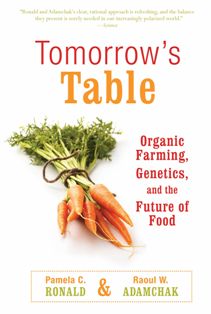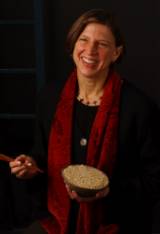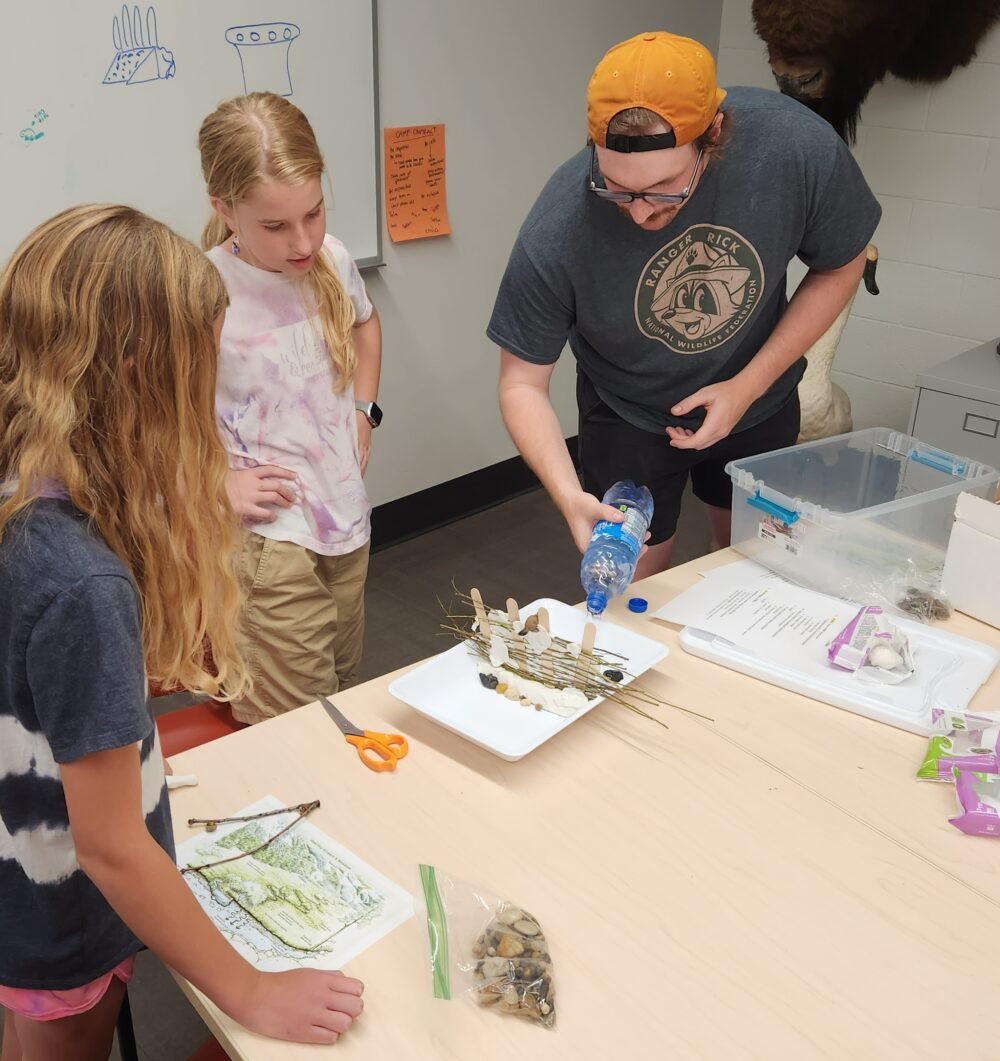We have much more to do and your continued support is needed now more than ever.
Five Questions: How Will Genetic Engineering Shape Sustainable Agriculture?
Pam Ronald’s new book on organic farming and the future of food, Tomorrow’s Table, highlights the latest research in the field of genetic engineering, and the ways it might solve water, habitat and toxicity issues inherent in conventional farming. We ask her five questions about her work, the education of future farmers, and how transgenic crops fight hunger in the developing world.

PR: The debate on genetic engineering is often a distraction from the most important issue, which is how we can make our agriculture more sustainable. What are the criteria for sustainability? For example, food should be safe to eat, we need to minimize the amount of wild lands that we devote to farming, we need to preserve biodiversity, and reduce toxic inputs to the environment such as harmful pesticides and fertilizer runoff. We also need to reduce the amount of water -we have fourfold less fresh water available per person in the world today as we did 50 years ago, and there’s no new water to be found. In the book, we also emphasize the need for helping the poor and malnourished in the developing world to produce their own food so that they have local food security.
Genetically engineered crops are really just one tool in addressing all this. Sometimes having an engineered seed variety is helpful, sometimes not. There is no need to use GE seed in all cases, but in certain cases, it makes all the difference. For example, the papaya crop in Oahu was devastated by a ringspot virus in the 1950s. There was no way to control it, so the farmers lost their crops and moved the orchards to Hawaii. A local Hawaiian named Dennis Gonsalves was concerned that the virus would spread to that island as well, so he started researching new ways to control the disease. By splicing a tiny piece of DNA from a mild form of the virus into papaya, he developed a new papaya variety that was resistant to the virus. This is mechanistically different but conceptually similar to the way physicians vaccinate humans against viral diseases. By 1992, when the virus had moved to Hawaii and started to devastate those crops, this new, resistant papaya was available, and saved the papaya industry. Today 90% of the papaya we eat in California is transgenic. That’s one really dramatic example.
Genetic engineering has also been really useful in reducing the amount of insecticide used for other crops: in AZ, many farmers use cotton engineered with Bt, which kills cotton bollworm. Farmers using GE cotton can reduce the amount of chemical treatment in half, and obtain the same yield as their neighbors growing conventional alfalfa. Plus, in the GE fields, you see a dramatic enhancement in species diversity: there are more ants and beetles in the fields. So there is a great benefit to be gained there in terms of reducing toxicity, increasing yield and enhancing biodiversity.
CE: One of the big issues in food is trust: how much can we trust our regulators to worry about our health and safety, and the long-term viability of soil and fields?
PR: That’s an important question, of who the public can trust. Anyone can go on the internet and find evidence for anything. I have a chapter in the book on trust, where I try to lay out why you might rely on information from a peer-reviewed study more than you would some websites.
It’s seemingly boring, but the public needs to have a good understanding of how science is done– through peer-review, transparency and reproducibility. Because it is too much for the average person to wade through a pile of scientific papers, I suggest they look at reports from the National Academy of Sciences, our nation’s most prestigious scientific association. They are a great resource to go to, because it’s all been vetted by experts. They have eminent scientists analyzing the data. What they and all other scientific agencies around the world have concluded is that the genetically engineered crops now commercialized are safe to eat and safe for the environment. There is not a single case of harm to human health or the environment. That doesn’t mean all new transgenic crop varieties are going to be safe. We have to look at each new variety on a case by case basis. Distinguishing fact from fiction can be hard, especially for non-scientists, which is why we need these public institutions.
Why do we need genetic engineering, can’t we just farm the old seed organically to create a sustainable agriculture? Organic farming has been an important step in raising awareness for the need of ecological farming and for reducing use of certain kinds of insecticide. But it is really just a first step toward a global sustainable agriculture, organic farming doesn’t take into account the amount of land and water that is used, the toxicity of insecticides (organic farmers are allowed to use quite toxic compounds), access to markets, productivity, the cost of the food (important in less affluent areas) or local conditions of pests and disease that can devastate a crop. Currently only about 2% of the farms in the US are certified organic.
CE: When talking about breeding plants for resistance to disease and pests, you note that pests evolve so rapidly that one plant variation is never a long-term solution: breeders have to keep experimenting. Who is doing a lot of this work?
PR: Breeding has been carried out in the public domain for centuries, and breeders are constantly working to release new varieties with improved resistance to pests and disease. In the past, breeders did this work by moving genes around through conventional breeding. In the past, universities like UC- Davis would introduce things to the world and make them publicly available, but that is changing. In the last 50 years or so, private companies in the US have starting doing most of the breeding in the U.S. In the rest of the world, most of the research is still carried out by public entities, though some corporations in India and China are following the U.S. example by privatizing some of the work. Today in the U.S. new varieties are released regularly by private companies, some of the seed is GE some of it is not.
CE: What are the biggest benefits that genetic engineering can offer the developing world?
PR: In the U.S., farmers can afford to use insecticides. They prefer to use less, because of the toxicity, and everyone wants to save money where they can, which means farmers want to use fewer insecticides. But in less-developed countries, often there isn’t even a choice. Farmers can’t afford to buy these insecticides, which puts them at risk of losing their crops, and sometimes these farms are only a couple acres in size.
There are also real health implications. 500,000 children die a year from the lack of Vitamin A, which comes in foods they can’t afford, and an even larger number lose their eyesight. However, there is a new kind of rice coming out called Golden Rice, funded by the Rockefeller Foundation, which has pro-vitamin A in the grains themselves. Recent published studies have predicted that thousands of children’s lives will be saved in the first year this rice is released.
CE: What’s interesting to me is the heavy focus on education. You spend a lot of time detailing how you taught these new methods to students, how you explained them. You even include an experiment that can be done by third-graders. This is a useful guide for the book itself, but it also makes me wonder how you think schools are doing in educating students about organic farming and genetically-engineered crops.
PR: Now, globally, more people live in cities than on farms, so there’s a need for good education in farming. Most people don’t know that virtually everything we eat has been genetically altered through conventional breeding. Most of the food we eat does not occur in the wild, nor would it survive there. Farms are bigger, but there are fewer, and there’s a general decline on what people know about farming and ecology and how difficult it is to grow food. So we would like to see more campuses looking at these kinds of issues. Some schools, like Stanford, are finding that there’s a big demand now among students in knowing more about global agricultural issues.
UC-Davis is unique. We have more plant biologists on the faculty than anyplace in the world. We have a student farm that’s certified organic, so this is one of the few places where people can come and learn to be an organic farmer. Students plant and weed and harvest and take food to the markets. My husband, who co-wrote the book with me, teaches them a lot of these practical techniques, and in my classes we talk more about the seeds and the genetics themselves. We try to give them basic information about what is known and the scientific consensus on issues, and then students will debate each other on particular topics, like “should the state of California ban GE crops?” During the debates they have to use peer-reviewed research. They can’t just go up there and be charming politicians! They have to cite their studies and have a good sense of the scientific literature. On the whole, students are very open to modern genetics. They are looking at the broader issues of sustainability and the global good. They aren’t alarmed by the idea of genetic engineering.

Pamela Ronald is Professor of Plant Pathology at the University of California, Davis, where she studies the role that genes play in a plant’s response to its environment. Her laboratory has genetically engineered rice for resistance to diseases and flooding, both of which are serious problems of rice crops in Asia and Africa. She also serves as Vice President for the Feedstocks Division and Director of Grass Genetics at the Joint Bioenergy Institute. Ronald received a B.A. from Reed College, an M.A. from Stanford University, an M.S. from the University of Uppsala in Sweden and her Ph.D. from UC Berkeley in 1985. She has received both Fulbright and Guggenheim fellowships.
Tomorrow’s Table, which she co-authored with her husband, Raoul Adamchak, an organic farmer, was selected as one of the best books of 2008 by Seed Magazine and the Library Journal. In 2009, Ronald received the National Association of Science Writers Science in Society Journalism Award. She writes an award-winning blog on food, farming and genetics here.





















